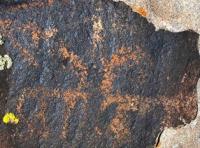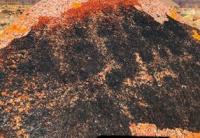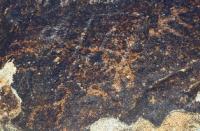You are here
Petroglyphs of Osh region.




Historic Petroglyph in Kyrgyzstan.
“...it seemed a part of her life, to step from the ancient to the modern, back and forth. She felt rather sorry for those who knew only one and not the other. It was better, she thought, to be able to select from the whole menu of human achievements than to be bound within one narrow range”
Orson Scott Card.
Legend Rock State Petroglyph Site Tour in Kyrgyzstan.
Osh oasis is part of the Osh-Karamu plain in the south-western part of the Fergana Valley, on the left bank of the Ak-Buury River, at the foothill of the Kichi-Alay Range. We present three groups of petroglyphs within this oasis: Sulayman-Too Mountains, Ayrymach-Too (Surottuu-Tash) and Kerme-Too.
They are located in Osh City, Kara-Su district of the Osh Province. In geographic literary sources, these sites are known as Oshskiye Gorki (Osh Hills), which surround Osh Oasis to the south, south-east (Sulayman-Too) and south-west (Kerme-Too), north and north-west (Ayrymach-Too).
The area surrounded by these mountains totals about 2,350ha. The eastern and north-eastern parts of the oasis open to the Fergana Valley. Research Status of the Sites. First information about Osh Oasis petroglyphs date to 1926, when Azhigirey G. reported on rock drawings of horses in the Ayrymach-Too (Surottuu-Tash) Mountains near Osh (Azhigirey 1928: 51).
This triggered research in 1939 by a group of associates from the archeological surveillance expedition at the construction of the Great Fergana Canal led by Masson M.E. They examined and described Aravan and Ayrymach-Too rock art.
Masson dated both groups of horses stylistically and according to information from Chinese chronicles about thoroughbred horses for which Davan – ancient Fergana – was famous in the IInd - Ist centuries BC to the second half of the 1st millennium BC.
In his 1948 article, Masson reported a somewhat different date: 1st millennium BC, possibly the middle of the century (Masson 1940: 131; 1948: 129 - 135) and pointed out that these drawings have cultic and magic importance.
A sketch of Aravan horses earlier published in a newspaper article was attached to the article (Masson 1939). A Tien-Shan-Alai archaeological expedition led by Bernshtam A.N. in 1946 again examined images of horses on a rock near the Aravan village (Duldul-Ata).
He dedicated his special work to these images (Bernstam 1948) and focused on their historical and cultural value. They document the existence of a horse cult in ancient Fergana, especially in the foothills of the valley.
By comparing these figures with reports from Chinese sources on breeding famous horses in the city Ershi, Bernshtam suggested that the majestic ruins of ancient settlement Marhamat, located near the Aravan Rock, could be the capital of Davan – the city of Ershi.
His drawings of Aravan horses were not exact copies, which reduces their documentary value. Ayrymach-Too images are repeatedly mentioned in several papers by Bernshtam, in which he agrees with Masson’s dating them to the Sako-Kushan period. In 1961, Zadneprovsky Yu.A. examined and recorded 34 images in the Surottuu-Tash Gorge at Ayrymach-Too.
He noted that the horses at Aravan and Ayrymach-Too dramatically differ in their stylistic characteristics, "therefore, comparison with other rock art sites does not help determinie the date of Fergana horses” and offered to look for analogies in different arts.
In particular, he stated “the striking similarity of the type of Fergana horse petroglyphs to images on Chinese tiles dating to the last centuries BC” (Zadneprovsky 1962), thus supporting the original dating by Masson to the second half of the Ist millennium BC. Masson and Zadneprovsky believed that the Aravan horses were similar to drawings at Ayrymach-Too.
In the mid - 1960s, an associate of the Osh museum, Cheylytko V.-R., made the first non-scientific excavations in Zhylaan-Unkura (Snake Cave) on Kerme-Too. He discovered petroglyphs on a vertical wall at the entrance to the cave, where materials from the Upper Paleolithic (?) to the early Middle Ages inclusively were found (Cheylytko 1965).
In 1970, Dyadyuchenko L.B. gave a description of the Osh Hills with photos of rock art at Sulayman-Too, Ayrymach-Too, and KermeToo in popular journals (Dyadyuchenko 1970, 1970a). He was the first to draw attention to the existence of cultic and ritual sites at Ayrymach-Too.
Sher Ya. A., who visited the sites in the years 1975 - 1977, contributed to the study of rock art at Sulayman-Too, Ayrymach-Too and their neighborhoods (Sher 1980). Systematic study and documentation of Sulayman-Too and Osh Oasis petroglyphs have been carried out since 1989 by the South-Kyrgyz Archeological Party of IHCH of NAS of the RK led by Amanbaeva B.E. within the framework of different national and international projects (Amanbaeva & Devlet 2000: 24 - 29).
As a result of many years of work, a sizeable baseline documentation was collected (maps, plans, indexed panoramas, and others) about petroglyphs and other sites at Sulayman-Too which has become eligible for the UNESCO World Heritage List (“Sacred Mount Sulayman-Too”).
Key sites of Fergana rock art on the territory of Kyrgyzstan were studied and documented in 2006 - 2009 within the framework of the UNESCO CARAD Project (Amanbaeva et al. 2006: 257 - 267).
Authority:
«Rock Art in Kyrgyzstan». Bakyt Amanbaeva, Aiday Suleymanova, Chynarbek Zholdoshev.
Photos by
Alexander Petrov.







